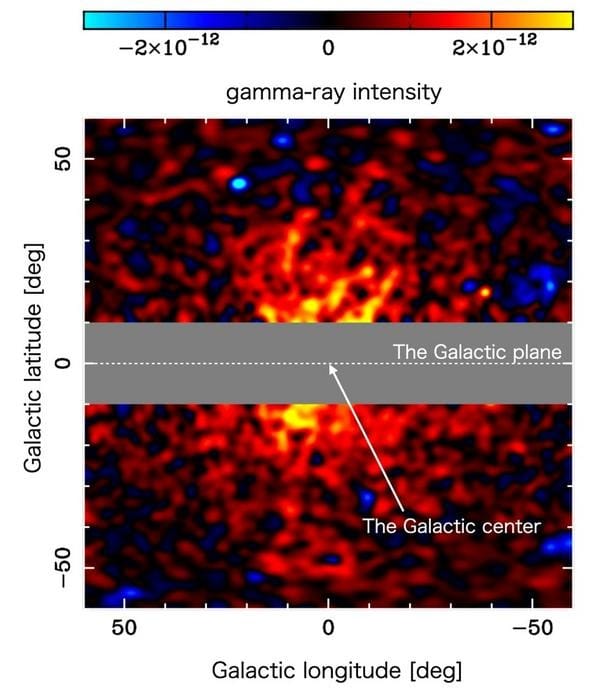An astronomer has reported a possible new signature of dark matter, a mysterious substance that makes up most of the universe, according to a study published on Tuesday in the Journal of Cosmology and Astroparticle Physics.
Dark matter accounts for 85 percent of all matter in the universe, but its existence has so far been inferred only from its indirect effects on the familiar “baryonic” matter that makes up stars, planets, and life.
Tomonori Totani, a professor of astronomy at the University of Tokyo and the author of the study, believes he has spotted novel indirect traces of dark matter particles in the “halo” surrounding the center of our galaxy using new observations from NASA’s Fermi Gamma-ray Space Telescope. When these speculative particles collide—a process called dark matter annihilation—the crash is predicted to emit bright gamma rays, which is the light that Totani thinks he has identified.
“The discovery was made possible by focusing on the halo region (excluding the galactic center), which had received little attention, and by utilizing data accumulated over 15 years from the Fermi satellite,” Totani told 404 Media in an email. “After carefully removing all components other than dark matter, a signal resembling dark matter appeared.”
“It was like playing the lottery, and at first I was skeptical,” he added. “But after checking meticulously and thinking it seemed correct, I got goosebumps!”
If the detection is corroborated by follow-up studies, it could confirm a leading hypothesis that dark matter is made of a hypothetical class of weakly interacting massive particles, or “WIMPs”—potentially exposing the identity of this mysterious substance for the first time. But that potential breakthrough is still a ways off, according to other researchers in the field.
“Any new structure in the gamma-ray sky is interesting, but the dark matter interpretation here strikes me as quite preliminary,” said Danielle Norcini, an experimental particle physicist and
assistant professor at Johns Hopkins University, in an email to 404 Media.

Dark matter has flummoxed scientists for almost a century. In the 1930s, astronomer Fritz Zwicky observed that the motions of galaxies hinted that they are much more massive than expected based solely on visible baryonic matter. Since then, astronomers have confirmed that dark matter, which accumulates into dense halos at the centers of galaxies, acts like a gravitational glue that holds structures together. Dark matter is also the basis of a vast cosmic web of gaseous threads that links galaxy clusters across billions of light years.
But while dark matter is ubiquitous, it does not interact with the electromagnetic force, which means it does not absorb, reflect, or emit light. This property makes it difficult to spot with traditional astronomy, a challenge that has inspired the development of novel instruments designed to directly detect dark matter such as the subterranean LUX-ZEPLIN in South Dakota and the forthcoming DAMIC-M in France.
For years, scientists have been probing possible emission from dark matter annihilation at the center of the Milky Way, which is surrounded by a halo of densely-clustered dark matter. Those previous studies focus on an excess emission pattern of about 2 gigaelectronvolts (GeV). Tontani’s study spotlights a new and different pattern with extremely energetic gamma rays at 20 GeV.
“A part of the Fermi data showed a peculiar excess that our model couldn't explain, leading me to suspect it might be due to radiation originating from dark matter,” he said. “The most difficult part is removing gamma-ray emissions of origins other than dark matter, such as those from cosmic rays and celestial objects.”
This tentative report may finally fill in a major missing piece of our understanding of the universe by exposing the true nature of dark matter and confirming the existence of WIMPs. But given that similar claims have been made in the past, more research is needed to assess the significance of the results.
“For any potential indirect signal, the key next steps are independent checks: analyses using different background models, different assumptions about the Milky Way halo, and ideally complementary data sets,” Norcini said.
“Gamma-ray structures in the halo can have many astrophysical origins, so ruling those out requires careful modeling and cross-comparison,” she continued. “At this point the result seems too new for that scrutiny to have played out, and it will take multiple groups looking at the same data before a dark matter interpretation could be considered robust.”
Though Totani is confident in his interpretation of his discovery, he also looks forward to the input of other dark matter researchers around the world.
“First, I would like other researchers to independently verify my analysis,” he said. “Next, for everyone to be convinced that this is truly dark matter, the decisive factor will be the detection of gamma rays with the same spectrum from other regions, such as dwarf galaxies. The accumulation of further data from the Fermi satellite and large ground-based gamma-ray telescopes, such as the Cherenkov Telescope Array Observatory (CTAO) will be crucial.”

